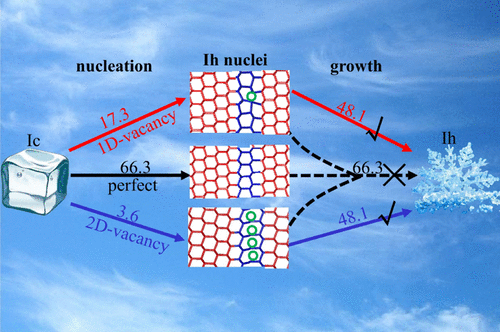当前位置:
X-MOL 学术
›
J. Phys. Chem. C
›
论文详情
Our official English website, www.x-mol.net, welcomes your
feedback! (Note: you will need to create a separate account there.)
Two-Stage Solid-Phase Transition of Cubic Ice to Hexagonal Ice: Structural Origin and Kinetics
The Journal of Physical Chemistry C ( IF 3.3 ) Pub Date : 2018-12-10 , DOI: 10.1021/acs.jpcc.8b08896 Shu-hui Guan 1, 2 , Cheng Shang 2 , Si-Da Huang 2 , Zhi-Pan Liu 2
The Journal of Physical Chemistry C ( IF 3.3 ) Pub Date : 2018-12-10 , DOI: 10.1021/acs.jpcc.8b08896 Shu-hui Guan 1, 2 , Cheng Shang 2 , Si-Da Huang 2 , Zhi-Pan Liu 2
Affiliation

|
Two most known ice phases, cubic (Ic) and hexagonal ice (Ih), are observed to coexist over a surprisingly broad low temperature range (150–240 K) in ice particles, the origin of which, despite great efforts devoted to revealing the ice microstructures in experiment, remains largely unknown. Here by combining global sampling with machine learning potential, the stochastic surface walking-neural network method, we reveal all key metastable intermediates during the Ic-to-Ih phase transition, which are basically low-energy structural defects in ice, including vacancies, heterophase junctions, and stacking faults. This leads to the first identification of the lowest energy pathways from ice Ic to Ih, where the presence of vacancy defects in ice allows the transformation kinetically by initiating a fast Ih nucleation. The subsequent migration of a vacancy, with a barrier of 48 kJ/mol, turns out to be the rate-determining step in Ih phase growth, rationalizing the unexpected prevalence of anisotropic stacking faults in low-temperature ice particles. This vacancy-controlled kinetics in Ih formation arises from the flexibility of the local geometry of a weaker H-bonding environment around the vacancy, which suggests that the frustrated material with a complex energy landscape may seek an unusual phase transition pathway with the help of a low level of heterogeneity.
更新日期:2018-12-11

















































 京公网安备 11010802027423号
京公网安备 11010802027423号